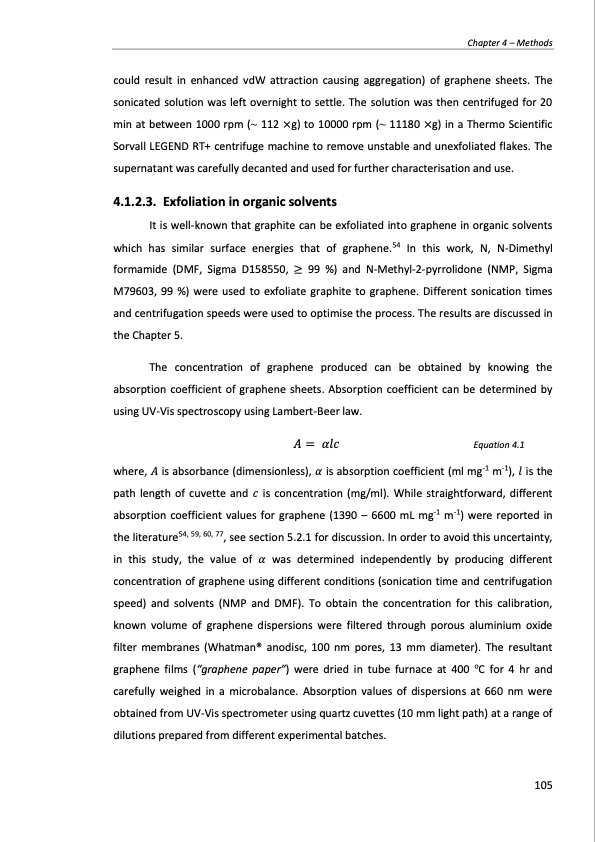
PDF Publication Title:
Text from PDF Page: 105
could result in enhanced vdW attraction causing aggregation) of graphene sheets. The sonicated solution was left overnight to settle. The solution was then centrifuged for 20 min at between 1000 rpm (~ 112 ×g) to 10000 rpm (~ 11180 ×g) in a Thermo Scientific Sorvall LEGEND RT+ centrifuge machine to remove unstable and unexfoliated flakes. The supernatant was carefully decanted and used for further characterisation and use. 4.1.2.3. Exfoliation in organic solvents It is well-known that graphite can be exfoliated into graphene in organic solvents which has similar surface energies that of graphene.54 In this work, N, N-Dimethyl formamide (DMF, Sigma D158550, ≥ 99 %) and N-Methyl-2-pyrrolidone (NMP, Sigma M79603, 99 %) were used to exfoliate graphite to graphene. Different sonication times and centrifugation speeds were used to optimise the process. The results are discussed in the Chapter 5. The concentration of graphene produced can be obtained by knowing the absorption coefficient of graphene sheets. Absorption coefficient can be determined by using UV-Vis spectroscopy using Lambert-Beer law. 𝐴 = 𝛼𝑙𝑐 Equation 4.1 where, 𝐴 is absorbance (dimensionless), 𝛼 is absorption coefficient (ml mg-1 m-1), 𝑙 is the path length of cuvette and 𝑐 is concentration (mg/ml). While straightforward, different absorption coefficient values for graphene (1390 – 6600 mL mg-1 m-1) were reported in the literature54, 59, 60, 77, see section 5.2.1 for discussion. In order to avoid this uncertainty, in this study, the value of 𝛼 was determined independently by producing different concentration of graphene using different conditions (sonication time and centrifugation speed) and solvents (NMP and DMF). To obtain the concentration for this calibration, known volume of graphene dispersions were filtered through porous aluminium oxide filter membranes (Whatman® anodisc, 100 nm pores, 13 mm diameter). The resultant graphene films (“graphene paper”) were dried in tube furnace at 400 oC for 4 hr and carefully weighed in a microbalance. Absorption values of dispersions at 660 nm were obtained from UV-Vis spectrometer using quartz cuvettes (10 mm light path) at a range of dilutions prepared from different experimental batches. Chapter 4 – Methods 105PDF Image | PRODUCTION AND APPLICATIONS OF GRAPHENE AND ITS COMPOSITES

PDF Search Title:
PRODUCTION AND APPLICATIONS OF GRAPHENE AND ITS COMPOSITESOriginal File Name Searched:
graphene-production-applications.PDFDIY PDF Search: Google It | Yahoo | Bing
Salgenx Redox Flow Battery Technology: Power up your energy storage game with Salgenx Salt Water Battery. With its advanced technology, the flow battery provides reliable, scalable, and sustainable energy storage for utility-scale projects. Upgrade to a Salgenx flow battery today and take control of your energy future.
| CONTACT TEL: 608-238-6001 Email: greg@infinityturbine.com | RSS | AMP |